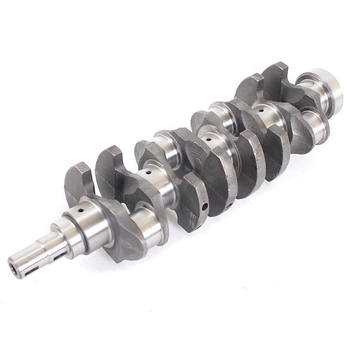The Unseen Enemy: Crankshaft Fatigue
When it comes to high-performance engines, crankshaft fatigue is a constant threat. This insidious enemy can lurk unseen, slowly weakening the heart of your engine until it's too late. But what exactly is crankshaft fatigue, and why does it matter?
Understanding the Crankshaft
To understand crankshaft fatigue, we first need to appreciate the role of the crankshaft in an engine. The crankshaft is responsible for converting the reciprocating motion of the pistons into rotational motion, which ultimately drives the vehicle's wheels. This critical component is subjected to enormous stress and strain during operation, particularly in high-performance engines.
The Onset of Fatigue
Crankshaft fatigue occurs when the metal becomes weakened due to repeated stress cycles. Over time, microscopic cracks can form and propagate, leading to reduced strength and stiffness. If left unchecked, these cracks can eventually lead to catastrophic failure of the crankshaft.
Preventive Measures: Material Selection
One of the most effective ways to prevent crankshaft fatigue is through careful material selection. Modern high-performance engines often use forged steel crankshafts, which offer superior strength and fatigue resistance compared to cast iron or cast steel crankshafts.
The Role of Forging
Forging creates a more uniform grain structure in the metal, improving its strength and fatigue resistance. Additionally, forged crankshafts can be heat-treated to further enhance their properties. Some high-end engines even utilize billet steel crankshafts, which are machined from a single piece of high-quality steel for maximum strength and durability.
Maintenance Matters: Detecting and Preventing Fatigue
Regular maintenance and inspection play a crucial role in preventing crankshaft fatigue. By monitoring the condition of the crankshaft and addressing any issues early on, you can significantly extend its lifespan and avoid costly repairs or replacements.
Visual Inspection
Periodic visual inspections can help identify signs of wear or damage, such as cracks, pitting, or excessive wear on the bearing surfaces. These inspections should be performed by a qualified technician who is familiar with the specific engine and its components.
Magnetic Particle Inspection
For more in-depth analysis, magnetic particle inspection (MPI) can be used to detect surface and subsurface cracks in the crankshaft. This non-destructive testing method involves applying a magnetic field to the crankshaft and using magnetic particles to reveal any discontinuities in the metal.
Proper Lubrication
Proper lubrication is essential for reducing friction and wear on the crankshaft bearings. Using a high-quality motor oil and changing it at the recommended intervals can help ensure adequate lubrication and protect against fatigue.
Practical Applications: Case Studies
Let's take a look at a couple of real-world examples of how these preventive measures have been successfully applied to high-performance engines.
- Race Team X: By switching to forged steel crankshafts and implementing a rigorous maintenance schedule, Race Team X was able to significantly reduce crankshaft failures and improve their overall engine reliability.
- Engine Builder Y: Through the use of advanced materials and manufacturing techniques, Engine Builder Y has developed a reputation for producing exceptionally durable high-performance engines with minimal instances of crankshaft fatigue.
In Conclusion: A Stitch in Time...
As the old adage goes, "A stitch in time saves nine." When it comes to preventing crankshaft fatigue in high-performance engines, this couldn't be more true. By investing in the right materials, maintenance practices, and inspection techniques, you can help ensure that your engine remains strong and reliable for years to come.
For more detailed information on preventing crankshaft fatigue and optimizing engine performance, please visit our official website: Crankshaft Fatigue




